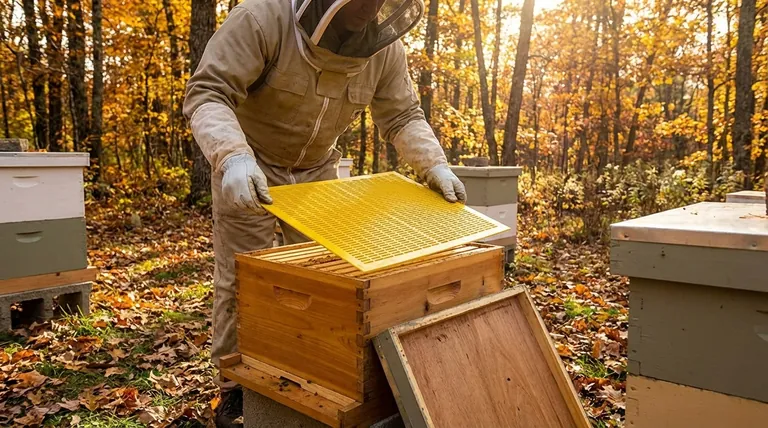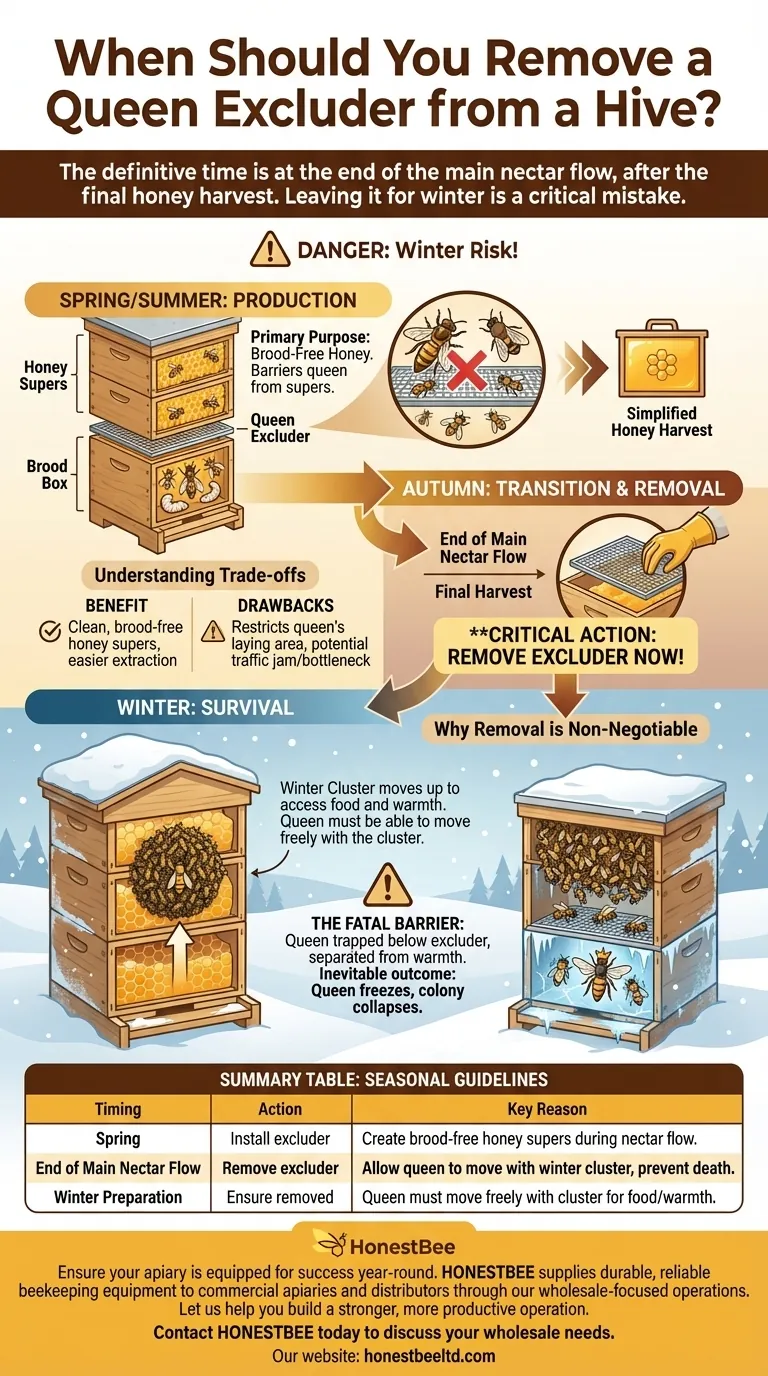The definitive time to remove a queen excluder is at the end of the main nectar flow, typically after you have completed your final honey harvest for the season. Keeping it in place as the weather cools is one of the most dangerous, and entirely preventable, risks a beekeeper can take with their colony's winter survival.
The queen excluder is a specialized tool for the honey production season, not a permanent piece of hive furniture. Its primary risk is that it can prevent the queen from moving with the winter cluster, leading to her death from cold and the subsequent collapse of the colony.

The Seasonal Role of the Queen Excluder
To understand why removing the excluder is so critical, we must first be clear on its intended purpose. It is a management tool with a very specific, seasonal job.
Its Primary Purpose: Brood-Free Honey
The sole function of a queen excluder is to create a barrier that worker bees can pass through but the larger queen and drones cannot.
It is placed between the brood boxes (where the queen lays eggs) and the honey supers (where you want bees to store surplus honey). This ensures your honey frames remain free of eggs, larvae, and pupae, which simplifies the harvesting process.
When to Install an Excluder
An excluder should only be placed on a strong, populous hive in the spring as the main nectar flow begins.
Installing it too early, when nighttime temperatures can still drop significantly, risks trapping the queen in a cold lower box away from the warmth of the main cluster. It should only be used when the colony is expanding rapidly.
Why Removal Before Winter is Non-Negotiable
As autumn approaches and temperatures fall, the behavior of the colony fundamentally changes from production to survival. The excluder now becomes a liability.
The Winter Cluster's Movement
Honey bees do not hibernate. Instead, they form a tight cluster to generate heat and survive the cold months.
This cluster is not static. It slowly moves upwards throughout the winter, consuming honey stores as it goes. The queen is always protected in the center of this cluster.
The Excluder as a Fatal Barrier
If a queen excluder is left in place, this upward migration can be fatal. The worker bees will move up through the excluder to access the honey stores above.
The queen, unable to pass through the barrier, gets left behind.
The Inevitable Outcome
Separated from the warmth and protection of her cluster, the queen will quickly freeze to death. The remaining cluster, though it may have ample food, is now queenless and doomed. It cannot survive the winter and will perish by spring.
Understanding the Trade-offs
While essential for clean honey production in many hive setups, using a queen excluder is a management decision with clear benefits and potential drawbacks.
Benefit: Simplified Honey Harvest
The primary advantage is clear: honey supers that contain only honey. This makes extraction cleaner and easier without the risk of damaging brood frames.
Drawback: Restricts Queen's Laying Area
In a very strong nectar flow, the bees may fill the brood chamber with honey so quickly that the queen runs out of space to lay eggs. This "honey-bound" condition can slow the growth of the colony.
Drawback: Potential Traffic Jam
Some beekeepers argue that forcing thousands of bees through the narrow gaps of an excluder can create a bottleneck. This may slightly reduce the efficiency of foraging and honey storage.
How to Apply This to Your Hive
Your decision to use and, more importantly, remove an excluder should be guided by the seasonal needs of your bees.
- If your primary focus is clean honey production in a vertical hive: Use the excluder during the main nectar flow and remove it immediately after your final harvest, well before the first frost.
- If you are preparing any hive for winter: The excluder must be removed. This is a critical step in your winterization checklist to ensure the queen can move freely with the winter cluster.
- If your focus is minimal intervention or you use a horizontal hive: You may choose not to use an excluder at all, accepting that the queen may lay in honey frames.
Properly timing the removal of your queen excluder is a simple but essential act of stewardship for your colony's health and survival.
Summary Table:
| Timing | Action | Key Reason |
|---|---|---|
| Spring | Install excluder | To create brood-free honey supers during the main nectar flow. |
| End of Main Nectar Flow | Remove excluder | To allow the queen to move with the winter cluster and prevent her death. |
| Winter Preparation | Ensure excluder is removed | The queen must be able to move freely with the cluster to access food and warmth. |
Ensure your apiary is equipped for success year-round. Proper hive management is key to colony health and honey production. HONESTBEE supplies durable, reliable beekeeping supplies and equipment to commercial apiaries and beekeeping equipment distributors through our wholesale-focused operations. Let us help you build a stronger, more productive operation. Contact HONESTBEE today to discuss your wholesale needs.
Visual Guide

Related Products
- Professional Plastic Queen Excluder for Modern Beekeeping
- Wooden Queen Bee Excluder for Beekeeping
- High Performance Plastic Queen Excluder for Beekeeping and Apiary Management
- Premium Wood Framed Metal Wire Queen Bee Excluder
- Plastic Queen Bee Excluder for Bee Hive Wholesale
People Also Ask
- What are the pros of using a queen excluder? Boost Hive Control & Honey Quality
- What is the purpose of a queen excluder when adding a super? Streamline Your Honey Harvest
- What is the primary function of a queen excluder in beekeeping? Control Hive Layout for Efficient Honey Harvesting
- What is a Queen Excluder and how does it work? Achieve Purer Honey & Better Hive Control
- What are the main advantages of using a queen excluder in beekeeping? Simplify Hive Management & Harvest



















